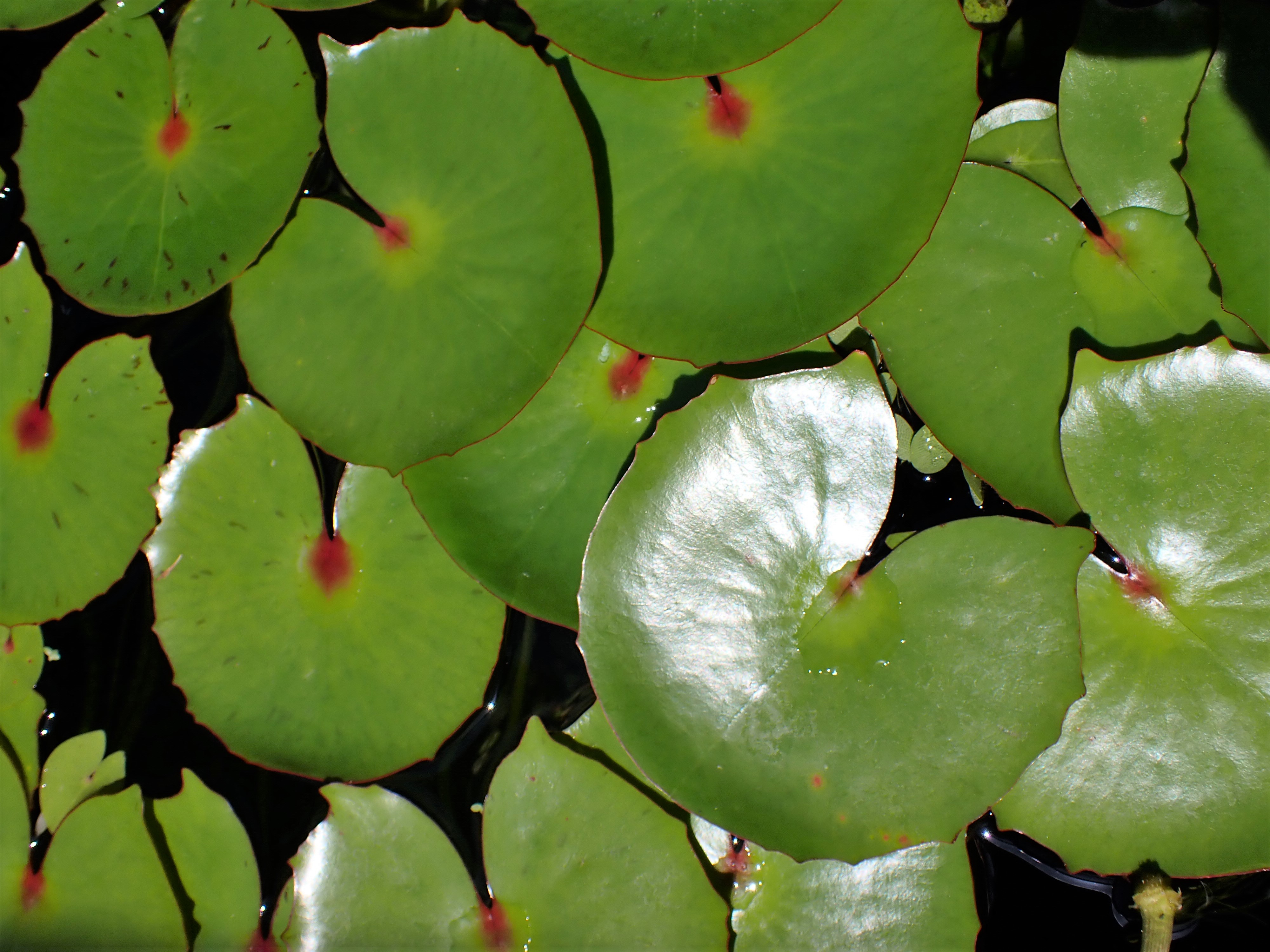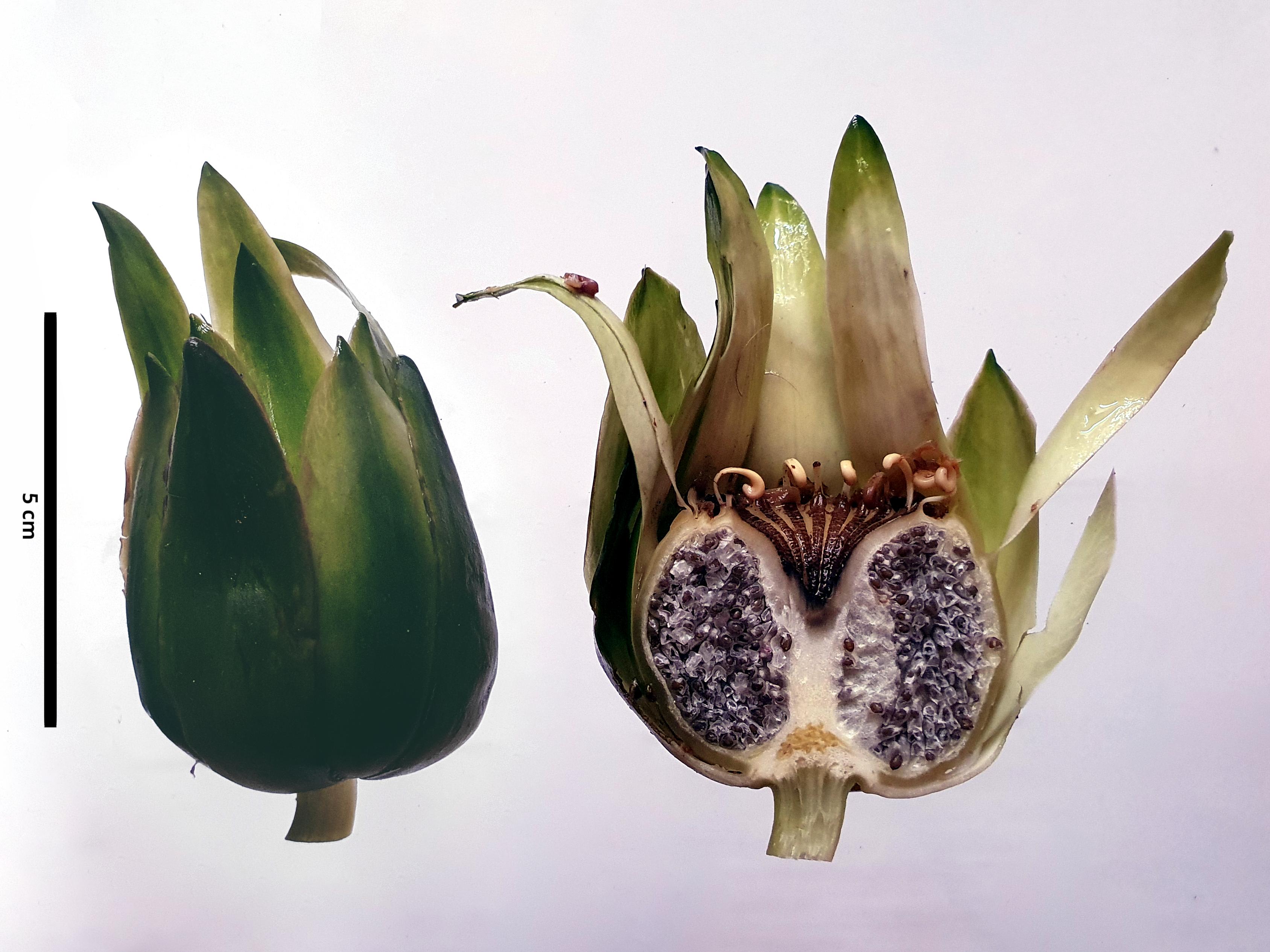Nymphaea Rudgeana on:
[Wikipedia]
[Google]
[Amazon]
''Nymphaea rudgeana'' is a species of waterlily native to the region spanning from Mexico to tropical South America.

 The ovoid to subglobose rhizome may exceed 7 cm in length and 8 cm in width. It is not
The ovoid to subglobose rhizome may exceed 7 cm in length and 8 cm in width. It is not
 The flower has four green or pink sepals, with or without blackish stripes. They are elliptic in shape with an acute to obtuse apex. The white to pink petals are gradually transitioning into stamens.Lima, C. T. D. (2018)
The flower has four green or pink sepals, with or without blackish stripes. They are elliptic in shape with an acute to obtuse apex. The white to pink petals are gradually transitioning into stamens.Lima, C. T. D. (2018)
"Flora das cangas da Serra dos Carajás, Pará, Brasil: Nymphaeaceae."
Rodriguésia, 69, 153-156. The floral fragrance has been described as lemon scented.Lóczy, L. (1897).
"Resultate der wissenschaftlichen Erforschung des Balatonsees."
p. 33. Austria: In Kommission von E. Hölzel. The rich, fruity odour is said to resemble the fragrance of '' Nymphaea amazonum''.Prance, G. T. (1980). A Note on the Pollination of ''Nymphaea Amazonum'' Mart. & Zucc. (Nymphaeaceae). Brittonia, 32(4), 505–507. https://doi.org/10.2307/2806159
"Population dynamics and net primary production of the aquatic macrophite ''Nymphaea rudgeana'' CF Mey in a lotic environment of the Itanhaém River basin (SP, Brazil)."
Revista Brasileira de Biologia, 60, 83-92. It has been observed growing in shallow waters of 20-100 cm in depth at river margins. It has also been found growin in an artificial lake with slight water flow.
"Phylogeny of ''Nymphaea'' (Nymphaeaceae): evidence from substitutions and microstructural changes in the chloroplast trnT-trnF region."
International Journal of Plant Sciences, 168(5), 639-671.
"A note on the pollination of nocturnally flowering species of ''Nymphaea''."
Acta Botanica Neerlandica, 24(5/6), 489-490.Prance, G. T., & Anderson, A. B. (1976)
"Studies of the floral biology of neotropical Nymphaeaceae."
3. Acta Amazonica, 6, 163-170. The insects are not trapped inside the flowers overnight. There have however been reports of consistently finding dead insects within the flowers.Henkel, F. (1907). Das Buch Der Nymphaeaceen Oder Seerosengewächse Von Fr. Henkel, F. Hehnelt und L. Dittmann. pp. 74-75. Deutschland: Friedrich Henkel.
"Rare and Endangered Plants of Puerto Rico: A Committee Report."
�p. 61. United States: U.S. Department of Agriculture, Soil Conservation Service. The IUCN conservation status is not evaluated (NE).
p. 285. (1897). Germany: R. Gaertners Verlagsbuchhandlung. The seeds are used as food by native people.
Description
Vegetative characteristics

 The ovoid to subglobose rhizome may exceed 7 cm in length and 8 cm in width. It is not
The ovoid to subglobose rhizome may exceed 7 cm in length and 8 cm in width. It is not stolon
In biology, a stolon ( from Latin ''wikt:stolo, stolō'', genitive ''stolōnis'' – "branch"), also known as a runner, is a horizontal connection between parts of an organism. It may be part of the organism, or of its skeleton. Typically, animal ...
iferous. Its leaves are thick and leathery, round to kidney-shaped or broadly heart-shaped. The leaf blade is 17-18 cm long and 19-21 cm wide. In deeper water, they can grow up to 35 cm. The margin is dentate and has uneven, blunt teeth, although towards the apex the margin is almost entirely smooth. It is the sole member of its subgenus featuring leaves with dentate margins. However, it also produces submerged leaves with entire margins, if it grows in flowing water. The adaxial leaf surface is shiny and light green with some red colouration in the centre and towards the edge. Younger leaves exhibit brownish red spotting. The abaxial leaf surface, which features protruding leaf venation, displays a brownish-purple colouration with irregular spotting. The petiole is reddish-brown, up to 9 or 11 mm wide, glabrous and has 2 primary, as well as 4 to numerous secondary air canals. From each leaf base, 6-7 roots emerge.
Generative characteristics
 The flower has four green or pink sepals, with or without blackish stripes. They are elliptic in shape with an acute to obtuse apex. The white to pink petals are gradually transitioning into stamens.Lima, C. T. D. (2018)
The flower has four green or pink sepals, with or without blackish stripes. They are elliptic in shape with an acute to obtuse apex. The white to pink petals are gradually transitioning into stamens.Lima, C. T. D. (2018)"Flora das cangas da Serra dos Carajás, Pará, Brasil: Nymphaeaceae."
Rodriguésia, 69, 153-156. The floral fragrance has been described as lemon scented.Lóczy, L. (1897).
"Resultate der wissenschaftlichen Erforschung des Balatonsees."
p. 33. Austria: In Kommission von E. Hölzel. The rich, fruity odour is said to resemble the fragrance of '' Nymphaea amazonum''.Prance, G. T. (1980). A Note on the Pollination of ''Nymphaea Amazonum'' Mart. & Zucc. (Nymphaeaceae). Brittonia, 32(4), 505–507. https://doi.org/10.2307/2806159
Cytology
The diploid chromosome count is 2n = 42.Reproduction
Vegetative reproduction
Asexual reproduction is not known to occur in this species. Both stolons and proliferating pseudanthia are absent in this species.Pellegrini, M. O. O. & Jardim Botânico do Rio de Janeiro. (n.d.-b). ''Nymphaea rudgeana'' G.Mey. Flora E Funga Do Brasil. Retrieved November 26, 2023, from https://floradobrasil.jbrj.gov.br/FB10949Generative reproduction
Cross pollination of the protogynous flowers occurs frequently. However, since the stigma remains receptive in the second day, which is when the pollen is released, autogamy is possible as well. The seeds are very numerous. In one case, 4365 seeds were found in a single fruit. A range of 1000 to 8000 seeds has also been reported.Conard, H. S. (2015). The Waterlilies: A Monograph of the Genus ''Nymphaea'' (Classic Reprint). pp. 204-206. USA: FB&C Limited.Habitat
It can grow in salty or brackish water.Wiersema, J. H. (1988). Reproductive Biology of ''Nymphaea'' (Nymphaeaceae). Annals of the Missouri Botanical Garden, 75(3), 795–804. https://doi.org/10.2307/2399367Camargo, A. F. M., & Florentino, E. R. (2000)"Population dynamics and net primary production of the aquatic macrophite ''Nymphaea rudgeana'' CF Mey in a lotic environment of the Itanhaém River basin (SP, Brazil)."
Revista Brasileira de Biologia, 60, 83-92. It has been observed growing in shallow waters of 20-100 cm in depth at river margins. It has also been found growin in an artificial lake with slight water flow.
Taxonomy
Type specimen
The type specimen was collected in Guyana by Rodschied.''Nymphaea rudgeana'' , International Plant Names Index. (n.d.). Retrieved November 27, 2023, from https://www.ipni.org/n/281442-2Wiersema, J. H. (1987). A monograph of ''Nymphaea'' subgenus ''Hydrocallis'' (Nymphaeaceae). Systematic Botany Monographs, 1-112.Placement within ''Nymphaea''
It is a member of ''Nymphaea'' subg. ''Hydrocallis''. However, it was speculated that ''Nymphaea rudgeana'' may be an ancient hybrid involving ''Nymphaea'' subgenus ''Lotos''.Borsch, T., Hilu, K. W., Wiersema, J. H., Löhne, C., Barthlott, W., & Wilde, V. (2007)"Phylogeny of ''Nymphaea'' (Nymphaeaceae): evidence from substitutions and microstructural changes in the chloroplast trnT-trnF region."
International Journal of Plant Sciences, 168(5), 639-671.
Etymology
The specific epithet ''rudgeana'' honours Anne Rudge.Stearn, W. T., & Williams, L. H. J. (1957). Martin’s French Guiana Plants and Rudge’s “Plantarum Guianae rariorum Icones.” Bulletin Du Jardin Botanique de l’État a Bruxelles, 27(2), 243–265. https://doi.org/10.2307/3666961Ecology
Pollination
The beetle species ''Cyclocephala castanea
''Cyclocephala castanea'' is a species of small beetle in the family Scarabaeidae which is native to the Amazon basin in South America. This beetle and certain others in the same genus have a commensal relationship with the large water lily ''Vi ...
'' and '' Cyclocephala verticalis'' visit ''Nymphaea rudgeana'' flowers.Gottsberger, G. (1986). Some Pollination Strategies in Neotropical Savannas and Forests. Plant Systematics and Evolution, 152(1/2), 29–45. http://www.jstor.org/stable/23673697M Cramer, J., Meeuse, A. D. J., & Teunissen, P. A. (1975)"A note on the pollination of nocturnally flowering species of ''Nymphaea''."
Acta Botanica Neerlandica, 24(5/6), 489-490.Prance, G. T., & Anderson, A. B. (1976)
"Studies of the floral biology of neotropical Nymphaeaceae."
3. Acta Amazonica, 6, 163-170. The insects are not trapped inside the flowers overnight. There have however been reports of consistently finding dead insects within the flowers.Henkel, F. (1907). Das Buch Der Nymphaeaceen Oder Seerosengewächse Von Fr. Henkel, F. Hehnelt und L. Dittmann. pp. 74-75. Deutschland: Friedrich Henkel.
Conservation
In Puerto Rico it is a rare species facinghabitat destruction
Habitat destruction (also termed habitat loss or habitat reduction) occurs when a natural habitat is no longer able to support its native species. The organisms once living there have either moved elsewhere, or are dead, leading to a decrease ...
.Woodbury, R. O. (1975)."Rare and Endangered Plants of Puerto Rico: A Committee Report."
�p. 61. United States: U.S. Department of Agriculture, Soil Conservation Service. The IUCN conservation status is not evaluated (NE).
Uses
Foliage and flowers are used asemollients
A moisturizer, or emollient, is a cosmetic preparation used for protecting, moisturizing, and lubricating the skin. These functions are normally performed by sebum produced by healthy skin. The word "emollient" is derived from the Latin verb ''mo ...
by the Palikur
The Palikur are an Indigenous people located in the riverine areas of the Brazilian state of Amapá and in French Guiana, particularly in the south-eastern border region, on the north bank of the Oyapock River. The Palikur Nation, or ''naoné'', ...
people of French Guiana.Hegnauer, R. (2013). Chemotaxonomie der Pflanzen: Eine Übersicht über die Verbreitung und die systematische Bedeutung der Pflanzenstoffe. p. 136. Germany: Birkhäuser Basel. Various other ethnobotanical uses were also reported: Decoction
Decoction is a method of extraction by boiling herbal or plant material (which may include stems, roots, bark and rhizomes) to dissolve the chemicals of the material. It is the most common preparation method in various herbal medicine systems. D ...
s were used for cases of morphea
Morphea is a form of scleroderma that mainly involves isolated patches of hardened skin on the face, hands, and feet, or anywhere else on the body, usually with no internal organ involvement. However, in Deep Morphea inflammation and sclerosis ...
, as a drink it was used against erysipelas
Erysipelas () is a relatively common bacterial infection of the superficial layer of the skin ( upper dermis), extending to the superficial lymphatic vessels within the skin, characterized by a raised, well-defined, tender, bright- red rash, ...
, and it has been used as treatment of facial tumours, toothaches and leprous wounds."Berichte der Deutschen Pharmaceutischen Gesellschaft."p. 285. (1897). Germany: R. Gaertners Verlagsbuchhandlung. The seeds are used as food by native people.
Cultivation
It is very rare in cultivation, although it may be easily cared for.Breukel, H. (n.d.-b). ''Nymphaea rudgenana'' G.F.W. Meyer - syn. ''blanda'' Planch. Seerosenforum.de Das Portal Der Seerose. Retrieved November 26, 2023, from https://www.seerosenforum.de/Gattung/Hydrocallis/rudgenana/rudgenana.aspx''Nymphaea rudgeana''. (n.d.). Flowgrow. Retrieved November 26, 2023, from https://www.flowgrow.de/db/aquaticplants/nymphaea-rudgeanaBIOTOPE AQUARIUM Project, & Khardina, N. (2022, September 5). Nymphaea rudgeana G.Mey. Biotope Aquarium Project. Retrieved November 26, 2023, from https://biotopeaquariumproject.com/plant/nymphaea-rudgeana-ig-sauvaudaua-nkhardina/Oczkowski, Y. (n.d.). Les plantes : ''Nymphaea rudgeana''. Aquavipare. Retrieved November 26, 2023, from http://www.aquavipare.fr/plantes/plante_detail.php?PlanteNomScientifique=Nymphaea+rudgeana It should be cultivated in high light conditions in rich, loamy fertile substrate at temperatures of 23 - 29 °C.References
{{Taxonbar, from=Q10338327 rudgeana Flora of Mexico Flora of Brazil Flora of Colombia Flora of Costa Rica Flora of Cuba Flora of French Guiana Flora of Guatemala Flora of Guyana Flora of Honduras Flora of Jamaica Flora of Nicaragua Flora of Panama Flora of Puerto Rico Flora of Suriname Flora of Trinidad and Tobago Flora of Venezuela Flora of Southern America Flora of Central America Plants described in 1818